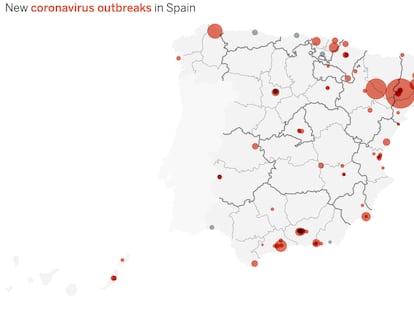Coronavirus hospitalizations in Spain reach their highest level in more than a month
The Health Ministry reported 263 new cases in the previous 24 hours, more than half of which were detected in Catalonia and Aragón

The majority of new coronavirus cases in Spain are mild, but as more and more people are diagnosed, inevitably the number of serious cases is rising too. Hospitalizations due to Covid-19 began to go up at the same time as infections in mid-June, but for weeks now they have stabilized, with few variations from 150 a week. The latest coronavirus report supplied by the Health Ministry on Tuesday evening, however, shows a slight rise in this data: 165 new admissions, the highest figure seen since June 6, when the number came in at 168.
This rise is not in step with new cases. While the latter has risen by five times in a month, hospitalizations have merely doubled with respect to their lowest figure: 86, on June 16. This is happening, as the ministry pointed out, because around 70% of detected cases are asymptomatic and do not require hospital treatment, and are being found thanks to contact tracing. The average age of people with new infections is also falling: 46 for men, and 50 for women. This fact is also leading to fewer complications for those with Covid-19.
Around 70% of detected cases are asymptomatic and do not require hospital treatment, according to the Spanish Health Ministry
The number of patients requiring treatment in an intensive care unit (ICU) remains closely linked to the number of hospitalizations, but with much lower figures. In the last week, just 11 people in all of Spain needed ICU treatment, around double the lowest figure seen since the crisis began: five, a number that was reported last week.
In terms of cases, the latest Health Ministry report showed that there were 263 new infections detected in the previous 24 hours, up on Monday’s figure of 154. This could, however, be due to the usual under-reporting of statistics by Spain’s regions over the weekend due to lower staffing levels. The figure is below the 333 cases reported on Friday, and in line with previous days.
The Aragón region, which has decided to return to restrictions equivalent to Phase 2 of the government’s deescalation plan in its capital cities, reported the highest number of new cases in the previous 24 hours, with 81, followed by Catalonia with 66. The health authorities are far more concerned about the situation in the latter region, however, given that there appears to be ongoing community transmission, a situation that has not yet come to pass in Aragón.
Other regions reported fewer cases yesterday, with 26 in Andalusia, 25 in Madrid and Galicia, 15 in Castilla y León, and 11 in Extremadura and Navarre. The remaining territories reported fewer than 10 new cases.
In terms of hospitalizations, the ministry reported 32 in Catalonia and 26 in Aragón. Madrid saw 25, Andalusia 18 and Castilla-La Mancha and the Valencia region 15.
Virus on the rise
Fernando Simón, the director of the Health Ministry’s Coordination Center for Health Alerts, reported on Monday that there are 15 Spanish provinces where the incidence of the virus is on the rise. They are: Lleida, Barcelona, Tarragona, Girona, Zaragoza, Huesca, Granada, Almería, Córdoba, Murcia, Badajoz, Guipúzcoa, Navarre, Lugo and Pontevedra. With the exception of those in Catalonia, the majority are areas where the virus was not present during the first wave in Spain, which began in February and March.
There are a number of reasons for this. In several of these provinces, such as Lugo, Zaragoza, Huesca and Lleida, there have been the biggest new outbreaks since the state of alarm introduced by the Spanish government was lifted. As such, it is not surprising to see a rise in infections in these areas.
Elsewhere, explains Pedro Gullón from the Spanish Epidemiological Society, it is possible that people are more susceptible to the virus given that fewer residents of those areas have had it already. “Although we are far from herd immunity, this could have some influence,” he says. The lack of a homogenous pattern in these provinces could also indicate higher levels of active tracing being carried out.
English version by Simon Hunter.
Tu suscripción se está usando en otro dispositivo
¿Quieres añadir otro usuario a tu suscripción?
Si continúas leyendo en este dispositivo, no se podrá leer en el otro.
FlechaTu suscripción se está usando en otro dispositivo y solo puedes acceder a EL PAÍS desde un dispositivo a la vez.
Si quieres compartir tu cuenta, cambia tu suscripción a la modalidad Premium, así podrás añadir otro usuario. Cada uno accederá con su propia cuenta de email, lo que os permitirá personalizar vuestra experiencia en EL PAÍS.
¿Tienes una suscripción de empresa? Accede aquí para contratar más cuentas.
En el caso de no saber quién está usando tu cuenta, te recomendamos cambiar tu contraseña aquí.
Si decides continuar compartiendo tu cuenta, este mensaje se mostrará en tu dispositivo y en el de la otra persona que está usando tu cuenta de forma indefinida, afectando a tu experiencia de lectura. Puedes consultar aquí los términos y condiciones de la suscripción digital.
